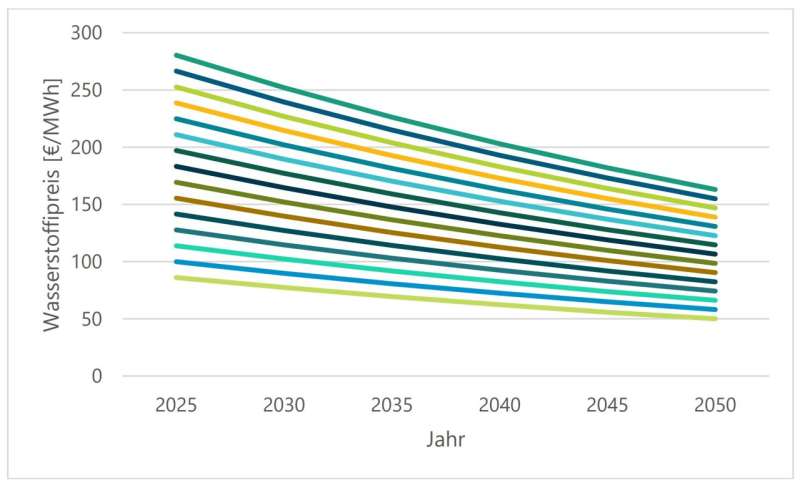This article has been reviewed according to Science X's editorial process and policies. Editors have highlighted the following attributes while ensuring the content's credibility:
fact-checked
trusted source
proofread
How could the demand for hydrogen and its price develop up to 2045?

Hydrogen is one of the pillars of the energy transition. However, there is still uncertainty about its specific applications and the scope of hydrogen use. A new study by Fraunhofer ISI addresses this issue and looks at the price-elastic demand for hydrogen in sectors such as industry, transport and energy conversion.
This study was conducted as part of the "HyPat—Global Atlas of H2 Potential" project. Specialized simulation models are used to depict alternative ways of achieving the climate goals.
Hydrogen and its derivatives have an important role to play in meeting climate goals, especially in achieving greenhouse gas neutrality—this is also highlighted in the German and European hydrogen strategies. However, it is still unclear how extensively hydrogen should be in used in which applications. A key criterion here is the price of hydrogen and its ability to compete with other options such as direct electrification, for example.
How will the demand for hydrogen develop in specific sectors under the goal of achieving greenhouse gas neutrality in 2045? The new study by Fraunhofer ISI and Energy Systems Analysis Associates—ESA² "Price-Elastic Demand for Hydrogen in Germany—Methodology and Results" tries to answer this question. Applications in industry, transport and energy conversion are analyzed using techno-economic, agent-based simulation models.
This approach enables statements to be made with respect to the price elasticities of hydrogen demand. Building heat and international air and maritime transport are also taken into account, but using the findings from other studies rather than our own modeling. The simulation models map the alternative options for achieving the climate goals and assess these from an economic viewpoint—for example, whether electric or fuel cell cars are economically more viable depending on the underlying prices.
Important drivers of hydrogen demand
One of the key results of the study according to Prof. Martin Wietschel, who led the project at Fraunhofer ISI, is "that so-called no-regret applications are a very important driver of hydrogen demand—these are applications for which there are hardly any economically-attractive alternative technology options for achieving Germany's ambitious greenhouse gas reduction targets." This lack of alternatives means that prices are largely inelastic and likely to remain relatively high in the future.
Wietschel continues, "This is especially true for the energy and material use of hydrogen in certain applications in industry such as in the steel or basic chemicals sectors. The calculations in the study show that demand here will amount to approx. 250 TWh in 2045, which is roughly 10 percent of today's final energy demand in Germany."
However, to achieve this, enormous electrolysis capacities of around 20 GW would have to be built in Germany alone, in other words, about 40 times the current globally installed electrolysis capacity—which is not only capital-intensive and time-consuming, but also requires rapid development.
In the transport sector and in international air and maritime transport, in particular, there is also likely to be a high, price-inelastic demand for synthetic fuels to reduce greenhouse gases (209 TWh in 2045), which could be met primarily by hydrogen and biogenic sources. This implies that hydrogen is not likely to be used in cars, trucks, buses or rail because there is the alternative of direct electrification here.
A more cost-favorable use of hydrogen is only possible at wholesale prices below 90 Euro/MWh in 2045, or even much lower, depending on the application. At a price of 50 Euro/MWh, the analyses yield a total demand for hydrogen of 476 TWh in 2045. However, this is not very likely due to diverse costs for production, transport or distribution.
Market prices significantly above 90 Euro/MWh in 2045 seem much more realistic. This is why it does not seem sensible to provide large-scale support for hydrogen use in sectors such as building heat, land-based transport or energy use in industry.
Prices will co-determine how much hydrogen will be used in future
In the energy conversion sector, however, demand for hydrogen could be relatively price-elastic—in a wholesale price range from 130 to 90 Euro/MWh. This is related to the fact that options to balance supply and demand are necessary for the targeted expansion of renewable energies.
Here, applications to use hydrogen storage and reconversion into electricity compete, among others, with applications to increase the flexibility of demand in the system, such as heat pumps, heat networks or electric vehicles. In addition, there is the option to use other storage options or to deploy even more
The results for 2030 show that hydrogen demand at this time will not be very high at just over 40 TWh. Certain industrial applications could dominate the demand for hydrogen. Support should focus on these in the coming years. In any case, low wholesale prices are not to be expected and are therefore not likely to contribute to raising the demand for hydrogen.
More information: Report (in German): www.hypat.de/hypat-wAssets/doc … tische-Nachfrage.pdf
















